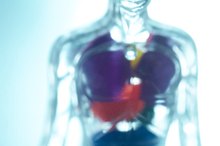Lacerated Kidney Symptoms
Kidney trauma occurs in 8 to 10 percent of patients experiencing severe blunt or penetrating abdominal trauma.
The Facts
There are several degrees of kidney lacerations: laceration of less than 1 cm that doesn’t affect the internal tubules and ducts; laceration greater than 1 cm that doesn’t affect the internal tubules and ducts; laceration extending to the inner kidney affecting the internal tubules and ducts; and complete laceration of the main renal artery.
The degree of the injury determines the severity, symptoms and course of treatment. Any damage to your kidneys can affect their function. A kidney laceration is particularly dangerous because it may go undetected initially.
Cause of Kidney Laceration
Bruised Kidney Symptoms
Learn More
Any abdominal trauma can lead to kidney lacerations. Some causes are result of a fall, an automobile accident or a bike accident. Depending on the severity of the laceration, extensive bleeding occurs into the retro peritoneal space. This is often the case when the laceration is deep enough to affect the inner kidney.
If you suffer a crack or a break of the 11th and 12th ribs, your ribs may have experienced trauma.
Symptoms
The symptoms depend on the severity of damage. A slight damage may show no symptoms initially. A lacerated kidney will be painful when a doctor examines the abdomen and flank. He will examine for Costovertebral angle tenderness (CVA tenderness).
Blood in the urine could also indicate damage to the kidneys. If you suspect possible damage (even when no symptoms exist), get examined by a health care practitioner.
Diagnosis
What Are the Causes of a Swollen Kidney?
Learn More
To determine how much damage has been done, a doctor may order a CT scan. Depending on what is found, a further study such as an aortogram will be performed. An aortogram is a diagnostic test in which a radiologist injects a dye into aorta. X-rays are then taken of the dye as it travels through the aorta. The severely lacerated kidney will show a leakage of dye. The doctor can then determine what treatments are necessary.
Treatment
Depending on the damage, some kidney lacerations can be managed without an operation, but surgical intervention may be carried out if the kidney shows extravasations of dye. Close observation of kidney function is sufficient if the laceration's severity is limited.
Prevention
If you are an avid biker or commonly engage in activities that include falls or inflict trauma to the abdomen, using a kidney belt can help prevent injury. Kidney belts are usually made from some sort of breathable elastic fabric and fastened with Velcro. They cover the lowest part of the back and the waist.
Related Articles
References
Resources
Writer Bio
Asba Lee is a former IT consultant who specialized in network administration and application development. Now a writer and academic instructor, Lee instructs GMAT, GRE and SAT courses. Lee loves to research and writes to learn new things, testing his thoughts and opinions.






